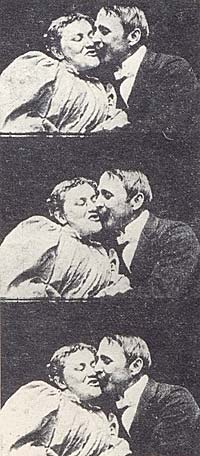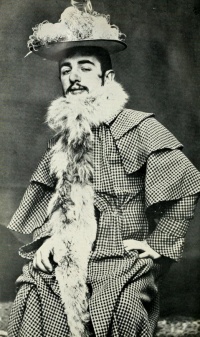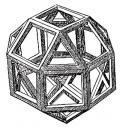1890s
From The Art and Popular Culture Encyclopedia

|
"We stand at the threshold of an altogether new art - an art with forms which mean or represent nothing, recall nothing, yet which can stimulate our souls as deeply as only the tones of music have been able to." --The Beauty of Form and Decorative Art, 1897-98, August Endell, on abstract art ""Literature was drawn into the firing line of the times. Novels and plays not only became more outspoken, but sentences became more epigrammatic and thoughts more paradoxical. No one could say how the most innocent of sentences might explode in its last word, any more than one could prophesy what somersault one's favourite belief might take in its latest incarnation. Surprises lurked in the most surprising literary places as though to reflect and keep time with the reshuffling of habits and conventions. And just as modern literature has gained in brightness by the experience, so the adventure has familiarised us with the need of variety in personality and of wider margins of freedom for its expression."--The Eighteen Nineties (1913) by Holbrook Jackson "Connected with the sexual psychopathy of M. Zola is the part played in him by the olfactory sensations. The predominance of the sense of smell and its connection with the sexual life is very striking among many degenerates."--Degeneration (1892) by Max Nordau "Yes, there is no doubt about it, this is an age which has a liking for unsavoury conduct. Who, after all, are the idols of the youth of today? They are Baudelaire, Villiers de L'Isle-Adam, Verlaine: three men of talent admittedly, but a sadistic Bohemian, an alcoholic, and a murderous homosexual."The Goncourt Journal, Edmond de Goncourt, January 27, 1895 "The term 'Pataphysics appeared in print in Alfred Jarry's play text L'autoclète: guignol in the April 28, 1893 issue of L'Écho de Paris littéraire illustré."--Sholem Stein |
.png)



.jpg)
|
Related e |
|
Featured: |
| << 1880s | 1900s >> | |
|---|---|---|
The 1890s were sometimes referred to as the "Mauve Decade," because William Henry Perkin's aniline dye allowed the widespread use of that colour in fashion, and also as the "Gay Nineties", under the then-current usage of the word "gay" which referred simply to merriment and frivolity, with no connotation of homosexuality as in present-day usage. The phrase, "The Gay Nineties," was not coined until 1926.
Contents |
General
- Settlement movement based on Jane Addams' Hull House in Chicago.
- Hale Johnson was a major leader of the American temperance movement.
- The fin de siècle (primarily in Paris and Brussels).
Art
- Moulin Rouge: La Goulue (1891), poster by Lautrec advertised
- Arts and Crafts movement
- Increasing importance of Art Nouveau style.
- The Scream (1893) by Edvard Munch
- Haystacks (Monet series)
Literature
- Hunger (1890) by Knut Hamsun
- The Picture of Dorian Gray (1890) by Oscar Wilde
- La Bête humaine (1890) by Émile Zola
- Degeneration by Max Nordau
- Sir Arthur Conan Doyle published the first Sherlock Holmes in Strand Magazine in 1891.
- Scatalogic Rites of All Nations (1891) by John G. Bourke
- Frank Wedekind releases Spring Awakening in 1891.
- Thomas Hardy published Tess of the d'Urbervilles in 1891
- Charlotte Perkins Gilman published The Yellow Wallpaper in 1892
- The Songs of Bilitis (1894) by Pierre Louÿs
- Rudyard Kipling published The Jungle Book in 1894
- H. G. Wells published The Time Machine (1895), The Island of Doctor Moreau (1896), and The War of the Worlds (1898)
- The Crowd: A Study of the Popular Mind (1895) by Gustave Le Bon
- Ubu Roi (1896) by Alfred Jarry
- Sexual Inversion (1896) by Havelock Ellis
- Bram Stoker published Dracula in 1897
- Joseph Conrad published Heart of Darkness in 1899
- The Torture Garden (1899) by Octave Mirbeau
- The Thirty-Six Dramatic Situations (1896) by Georges Polti
Music
- Ragtime music
- "Tar-ra-ra-boom-der-ay" (1891) by Henry J. Sayers
- Prélude à l'après-midi d'un faune (1894) by Debussy
- music halls (height of popularity)
- Tin Pan Alley
- "Funeral March for the Obsequies of a Deaf Man" by Alphonse Allais
Technology
- phonograph (enjoys popularity)
- telephone (enjoys popularity)
- early commercial production of cars
Film
- L'Arrivée d'un train en gare de La Ciotat
- cinema (first paying audiences)
- The Kiss (1896 )
It was in America that people were first induced to pay to watch -- in May 1895 in a store on Broadway. In Europe it was not until November 1895 in Berlin that a movie was shown in public.
The quality of the movies shown in New York and Berlin were extremely poor and used processes that had no lasting impact on movie technology. The "true" debut of the motion picture is therefore usually dated to December 28, 1895 in Paris, where at the Grand Cafe in Boulevard des Capucines the Lumière brothers had their first paying audience.
Theatre
Sociology
- Degeneration (Nordau, Lombroso)
- New Woman (feminism)
- first pin-up girls
- Decadent movement
- start of psychoanalysis in Vienna
- Lynchings of African Americans in the United States averaged 150 per year
- 1897 Magnus Hirschfeld founds the Scientific Humanitarian Committee
Births
literary
H.P. Lovecraft, Henry Miller, Walter Benjamin, Edogawa Rampo, Céline, Aldous Huxley, Paul Éluard, Antonin Artaud, André Breton, Louis Aragon, Georges Bataille, Bertolt Brecht, Vladimir Nabokov, Henri Michaux
Other
Erich Auerbach, Bruno Schulz, Josef von Sternberg, Jean Renoir, Alfred Kinsey, Mikhail Bakhtin, Max Horkheimer, Dziga Vertov, André Masson, Wilhelm Reich, Jean Epstein, Sergei Eisenstein, René Magritte, Herbert Marcuse, Tamara De Lempicka, Alfred Hitchcock
See also
_-_Henri_Rousseau.jpg)


